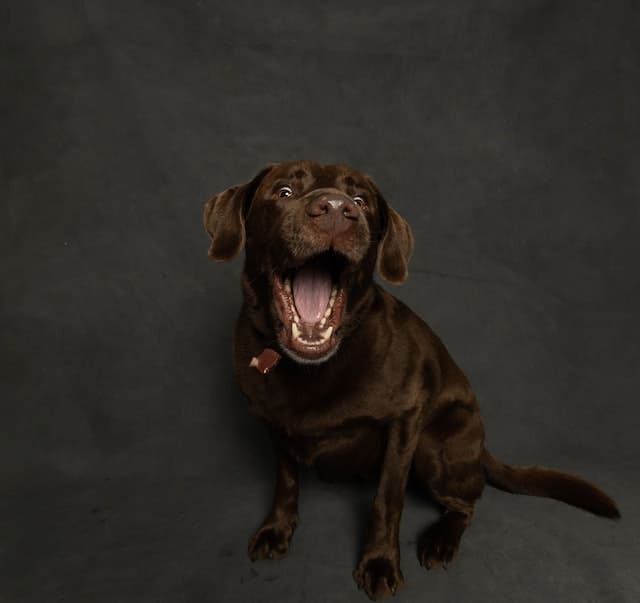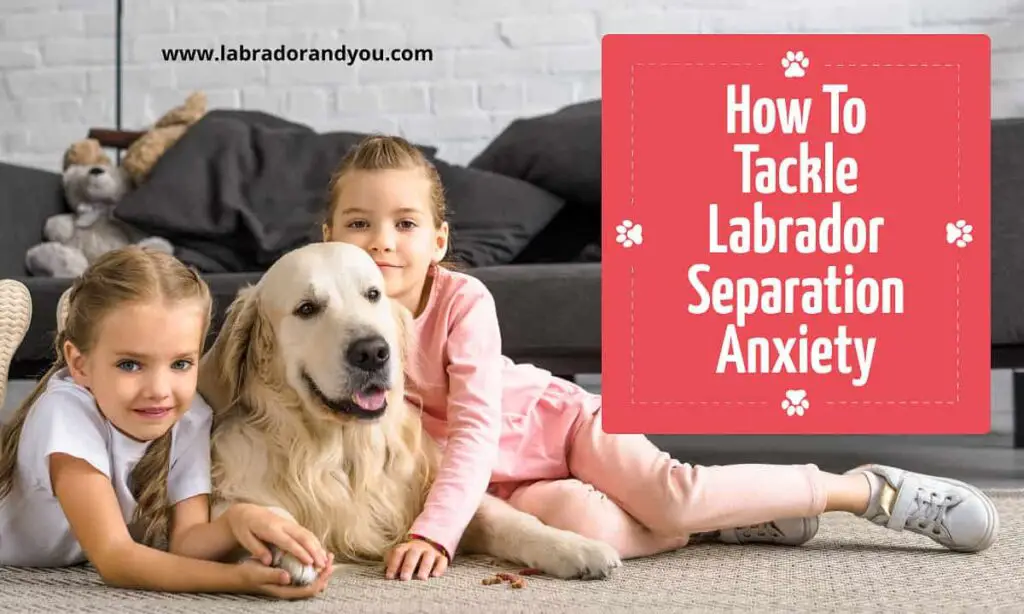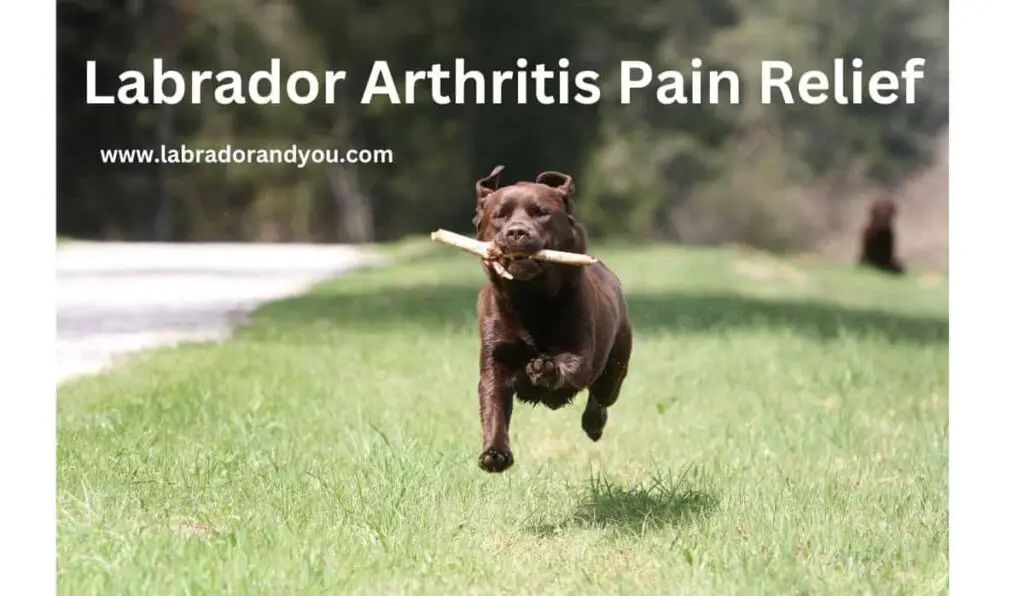A Labrador puppy is active and outgoing. Their temperament makes them excellent family dogs. Training a labrador retriever puppy takes time. Start training early with basic commands and obedience training. Slowly move into potty training and crate training. Buy a good leash and hold them high. Remember, their retrieving nature makes them great as hunting dogs. We’ll go into detailed depth on how to train a labrador.
How to train a Labrador Retriever: Young Puppy To Adult Dogs
Eight-week Lab puppies can safely leave their mothers. Here are a few key milestones to be achieved once you have welcomed the eight-week-old pup.
Labrador Retriever Training – 8 Weeks
Puppy Proofing
- Puppy proofing is a must for new dog owners. Keep the items out of sight that you don’t want your lab to chew.
- Stock up on as many chew toys as you can.
- Some food and plants can be poisonous for your labrador. A few plants include Autumn Crocus, Begonia, Daffodil, etc. Remove them from your home.
- Food items like garlic and ice-creams are a no for your dog.
Socialization
It is the most crucial part of your puppy training. If you have one, it is essential to introduce the labrador puppy to the older dog.
- Feed the older one and then feed the new one separately in the crate. The dogs will better understand the hierarchy.
- Supervise them till the pets in the house get along. Ensure they are friendly with each other and not too wild.
Grooming
Get your labrador puppy into grooming habits right from the beginning.
- Keeping the lab’s nails short, teeth clean, and ears neat are a few starters. This combo can work as a weekly routine.
- Bathing your labrador puppy once a month helps ensure easy grooming.
House Training
A Labrador puppy is a fantastic student. They are quick learners because they love to please.
- They must be taken out for potty training outside once they wake up.
- Obedience and other advanced training must be avoided at this stage.
- However, fun games like fetch and leash walking can be introduced.
How to train a Labrador Retriever At 3-6 Months?
Swimming
Teach your labrador puppy how to swim in the third month. Don’t throw them away in the pool. Use water safety tips, a life jacket, and a flotation device. Teach them how to swim and come out safely.
Stairs
It is alright for your pup to go in and out of the house. Using stairs is only recommended once the labrador retriever puppy is four months.
Obedience Training Classes
Your labrador will receive the first round of vaccines in the fourth month. An obedience program ensures safety while taking the shots. The pup’s teeth will likely become loose and fall during the fourth or fifth month. As adult teeth come on, labs may bite more but playfully.
Leash walking is short till six months and can be extended from then. Finding the right instructor and training equipment is vital. Here’s how to do obedience training for your labrador retriever puppy:-
- Start with Basic Commands: You should start with basic commands such as “sit,” “stay,” “come,” and “heel.” Give them treats to encourage good behavior.
- Short Training Sessions: Keep sessions short and frequent to help your puppy stay focused. Aim for 10-15 minute training sessions, 2-3 times daily.
- Use a Training Collar: Consider using a training collar to help reinforce commands. Use it as directed, and never leave it on your puppy when unsupervised.
- Distraction Techniques: Use distraction techniques such as toys or treats to redirect your puppy’s attention when they get distracted. Be patient.
- Socialization: Socialize your labrador puppy with other dogs, people, and environments. This helps them develop good behavior and manners in different situations. Take your puppy to the dog park.
- Practice in Different Environments: Practice obedience training in different environments to help your puppy generalize the commands. Start in a quiet environment and gradually increase distractions.
- Advance to Complex Commands: Once your puppy has mastered basic commands, advance to more complex commands such as “down,” “leave it,” and “drop it.” Food treats act as a good motivator
- Reinforce Good Behavior: Continue reinforcing good behavior with treats, praise, and playtime. Avoid using punishment or negative reinforcement, as this can damage the bond between you and your puppy.
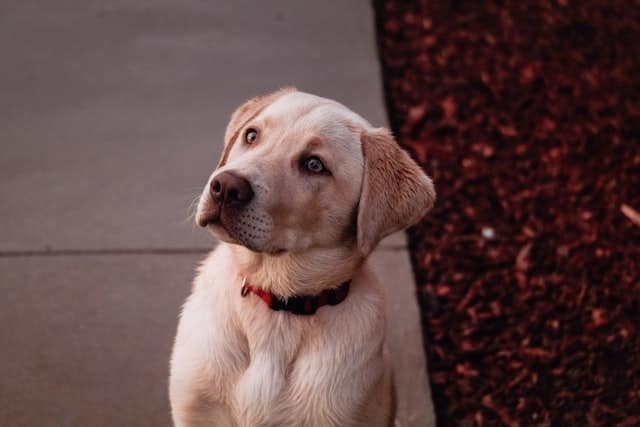
Labrador Retriever Puppy Training – 7+ Months
The young dogs will be sexually mature now. The first period can happen as early as the seventh month or until age two.
- Discuss the neutering and spaying option with your vet before the period.
- Diapers can be used to make things manageable for your lab.
- Save the food transition and jogging for your labrador puppies’ first birthday.
- Your 12-month lab is ready to transition to adult dog food from puppy food.
Stick to the above recommendation for effective puppy training.
10 Commandments Of Labrador Retriever Training:
Here are 10 commandments on how to train a labrador retriever into a well-mannered and obedient dog.
#1 – Learn How To Read Your Labrador Puppy
A dog’s body language displays several signs regarding its thinking. Be 1 step ahead and try to recognize their body language. Learning to read your labrador pup is among three pivotal training tips.
- A wagging tail high in the air signifies a happy mood. Simultaneously, a tail between the legs can mean they are not enjoying the task.
- If the ears are forward and in the outside direction, your lab is in a good mood. However, if they are flattened and against the head, he may not be in an enjoyable mood.
- Is your dog licking too much? It may signify stress or a state of confusion.
Paying attention to cues like this can help you respond quickly and efficiently. You can read their intention and avoid dangerous situations.
#2: Ensure Your Labrador Puppies Know What You Are Asking Him To Do
As your dog owner, ensuring your dog understands your command is vital. Mixed messages can make labrador retriever dog training tough.
If you are angry and talking to your lab sweetly, it confuses them. Giving mixed signals hamper both training and communication. Another crucial trait is to make the lab place orientated. While they understand the sit command inside the house, things can be different outside.
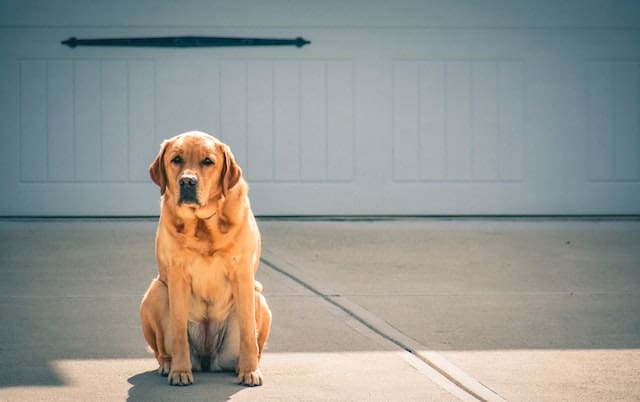
#3: Keep Commands Simple And Clear
Keep your commands simple. Several dog owners add too many words making it sound like they are speaking to a toddler. Short commands work best and are critical to effective labrador training. Another thing to follow is consistency. If you are using COME, then you can stick to it. Refrain from using HERE!
This is the most important of the top three labrador training tips.
#4: Understand And Use Pressure Correctly
Attrition, direct, and indirect pressure types must be used differently. Here is a training example of your new labrador puppy doing blind retrieves to help you understand better.
- Attrition pressure ensures the lab performs the task correctly. The lab is stopped repeatedly by using attrition till it takes the hand cast.
- Direct pressure is used to stop the dog immediately. Pressure is given through an e-collar to correct a wrong behavior instantly.
- Indirect pressure involves giving pressure to a familiar command. As a result, your lab learns they are being corrected for wrong behavior and puts in the right effort.
Irrespective of the pressure type, your dog needs to understand the requirement. The proper training makes them know why they are being corrected. Understand the pressure application well for being better at labrador training.
#5: Plan And Log Every Lab Puppy Training Schedule
Logging each labrador puppy training schedule helps keep a better performance track. You can plan what to do in a particular session or the following one.
It will assist in identifying which area needs repetition or extra time.
Say no to a non-productive training session or operating without a labrador training plan.
Some trainers make the mistake of making their dogs only do what they are good at. The goal is to push your dog in skill expansion. Give short lessons to train right. They are more productive. Pay close attention to their body language and train accordingly.
#6: Communication Is More Than Words
Your labrador retriever interprets everything being said. So, use a few words to communicate. This is such an important thing. Babbling incessantly leads nowhere. For example, when you say SIT, your lab must understand it. You needn’t speak long sentences with unnecessary words.
Your body language is another sphere of attention as it can impact more than your words. Young puppies have a habit of interpreting body language. Ensure it matches your words and does not give mixed signals.
#7: Good Timing
Timing conveys giving a signal or command at the appropriate time. Most dogs are likely to understand the correct timing. Praise and punishment need to be used alternatively to repeat or stop a particular behavior.
Scolding a pupping for peeing on your sofa after two hours is poor timing. Address the issue immediately for your puppy to understand. The same applies while giving commands. New puppies may refuse a command, but enforcing it will result in a great puppy class.
A great dog understands and responds to you. Your dog also needs a recharge. Cut the sessions short if needed and cater to their attitude and health.
Tip #8 – Getting The Most Value Out Of Praise
Praise is crucial whether a golden retriever or a labrador retriever. Some people praise their labs for everything they do. Labrador owners must avoid constant praise. Learn the difference between praise types and how they must be incorporated into the training process.
- A dog may not feel the same way when he receives treats for understanding the sitting command when old. An old labrador retriever will not jump around on receiving a small treat.
- Praising your lab from far away is insignificant. They must be able to hear your praise and be in a state of mind to receive it.
- Well-timed praise results in correct behavior in your lab. Immediately after performing a desired action, sweet words will help the dog understand better.
#9 – Never Use Punishment
Never use punishment to train or make your labrador retriever puppy heed to you. Inexperienced dog owners use electric dog collars. They do more harm than good and must be avoided. Avoid using electronic collars for training your labrador retriever
#10 – Consistent Communication, And Firm Expectations
Quality body language, few words, and consistency are key. This is the 3rd most important training tip. If too many members are in the house, they must use the same vocabulary. Everyone must be on the same page. Refrain from getting into a begging situation with your retriever.
Agree on the commands and finalize using give or leave, here or come, and kennel or place! When others use a different command, it confuses labs and is not good.
Training takes time. 6 months is when to start training a lab puppy for hunting if desired. The trick is understanding dog psychology, whether for guide or therapy dogs. Learning about the common problems with your dog breed is good.
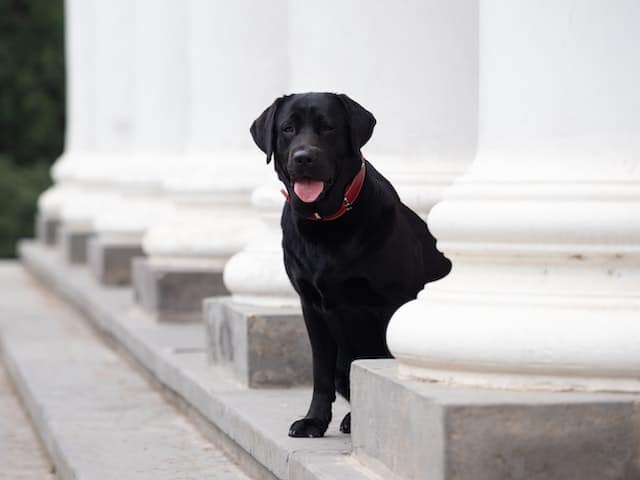
Crate vs. House training a labrador retriever.
Training Using Enclosed Spaces- Crate
Crate training helps your new puppy is beneficial as a pup sees its crate as a unique place. A crate becomes a helpful tool for better management. Here are a few steps –
- Choose a crate that is appropriate for your dog’s size and breed.
- Place the crate in a common area of your home where your dog can see and hear you.
- Introduce your dog to the crate by placing treats and toys inside it.
- Encourage your dog to enter the crate independently, and reward them with treats and praise.
- Close the crate door for a few seconds while your dog is inside, then open it and reward them.
- Gradually increase your dog’s time in the crate with the door closed.
- Practice leaving your dog in the crate for short periods while you are home. Gradually increase the time you are away.
- Ignore whining or barking while your dog is in the crate, as giving in will reinforce bad behavior.
- Use the crate to manage your dog’s behavior, such as during meal times or when visitors come over.
Additional Pointers to keep in mind:
- Never use the crate as a punishment; always ensure your dog can access food, water, and toys.
- Choosing the correct style and size of the crate is essential. While too small can be cruel, a large one can be ineffective.
- The first steps include size, and the next is to decide on items to fit in. Buy a few essential items to make it warm.
- An ideal age to start crate training is when your lab is a puppy. You can crate-train an older dog, but it requires much time.
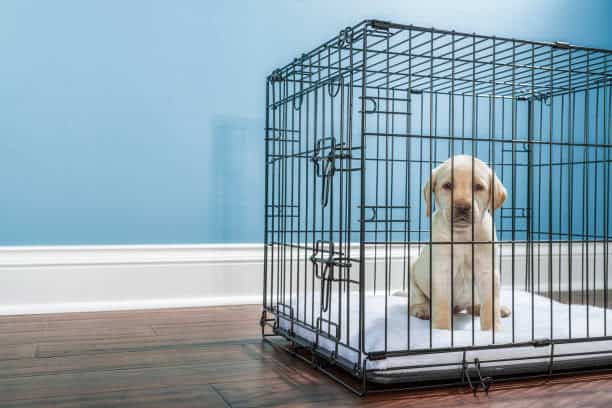
House Training
House training will prevent your lab from urinating anywhere in the house. The training teaches your dog about acceptable toilet behavior right from the start. Not just your labrador retriever but every breed can be house-trained similarly. Here are a few considerations.
- Learn how long the training will take, puppy toilet durations, bowel control, etc.
- Check the essential products and supplies needed. A few include – a leash, tarpaulin sheet, poop bags, puppy pads, etc.
- Accidents are common in house training. Read about the common reasons and how you can prevent them.
- Select quality feeding brands to safeguard your pet’s tummy.
- Crate training is an integral part of house training.
House training methods are meant to avoid problematic habits and ensure pet safety. The training can be challenging, but you will reap rewards. Call your vet to know which can work better.
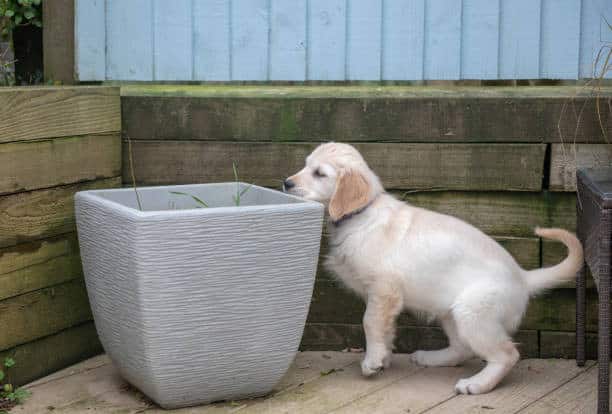
Behavior Problems While Training A New Puppy
Most dog owners report common behavior problems with their pets.
- Dragging their owners behind them
- Some do not come back when called
- A few jump and push people
Taking control of your dog is essential. Use generous rewards to control the dog’s behavior.
- Start treating them in gaps to prevent them from jumping too much.
- Feeding them on the ground instead of by hand can also benefit from distracting them from new visitors.
Know Why Service & Guide Dogs Require Professional Help?
Training young puppies take patience. Labs love to make their owners smile. These make them excellent service dogs. Labs can be awesome therapy dogs. To excel, the lab needs professional help. A certified professional or dog trainer can help. Young dogs can identify cues like changing glucose levels, picking objects, alerting them to certain sounds and scents, etc.
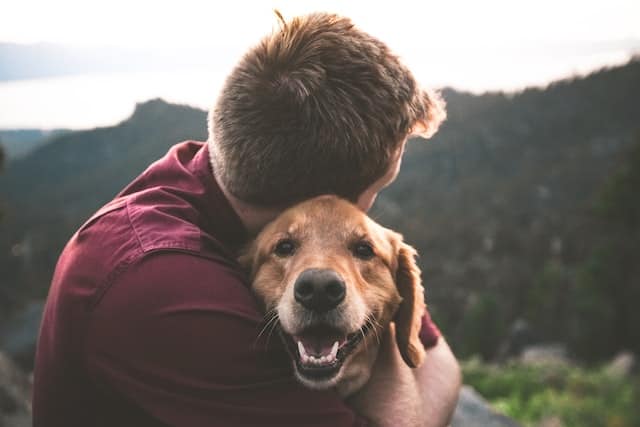
Lab Training for Hunting
Before you start training your Lab for hunting, you must ensure they have basic obedience training. This includes commands such as “sit,” “stay,” “come,” and “heel.” These commands will provide a foundation for more advanced training.
Retrieval Training
Retrieval training is the cornerstone of lab training for hunting.
- First, you should train your Lab to retrieve a dummy or bumper.
- Begin by throwing the dummy a short distance and encouraging your dog to retrieve it.
- Once they have mastered this, gradually increase the distance and difficulty of the retrieves.
Scent Training
Scent training is another important aspect of lab training for hunting. Your dog needs to be able to locate the game by scent.
- Start by hiding a treat or toy in a designated area.
- Encourage your dog to find it using its sense of smell.
- Gradually increase the difficulty by hiding the object in more complex locations.
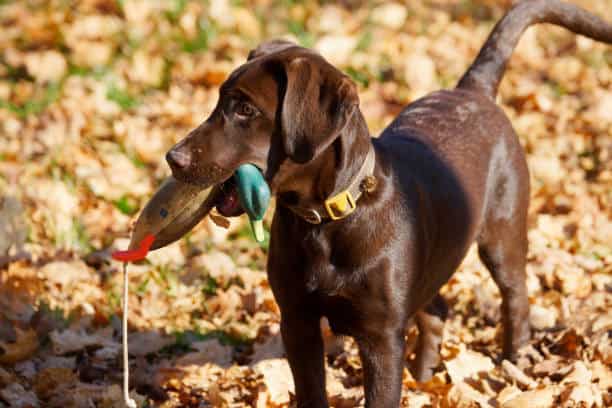
Water Training
Labs are excellent swimmers, so water training is an important part of their hunting training. Start by introducing your dog to water gradually, using reinforcement techniques. Once your dog is comfortable in the water, introduce them to retrieving it in the water.
Gun Training
Your hunting dogs must be comfortable with the sound of guns and around guns. Start by gradually introducing your dog to a gun’s sound. This is where positive reinforcement training comes in handy. Once your dog is comfortable with the sound of a gun, gradually introduce them to retrieving with gunfire.
labrador training tips
Consistency
Your dog needs to understand that certain behaviors are expected of them, and consistency in training will help them learn faster.
Positive Reinforcement
Positive reinforcement is the most effective way to train your dog. This includes using treats, praise, and play to reward good behavior.
Patience
Training a labrador retriever for hunting takes time and patience. Don’t rush the process or get frustrated with your dog. Remember, they are learning, and it takes time.
Safety
Safety is the most important aspect of hunting. Always ensure that your dog is safe and comfortable and that you are following all hunting regulations and laws.
Recommended Books
There are many books available that provide detailed information on lab training for hunting. Here are a few of our top recommendations:
- “Training Your Labrador Retriever” by September Morn
- “The Complete Guide to Hunting with Labradors” by Joanna De Klerk
- “Water Dog: Revolutionary Rapid Training Method” by Richard Wolters
8 Best Labrador Retriever Training Books
1. The Art of Raising a Puppy by The Monks of New Skete
The Art of Raising a Puppy is an excellent book for first-time Labrador Retriever owners. This book covers everything from choosing the right breed to housebreaking and basic obedience training.
The Monks of New Skete have over 30 years of experience raising German Shepherds and have applied their knowledge to raising and training all breeds of dogs.
2. Zak George’s Dog Training Revolution by Zak George
Zak George is a well-known dog trainer and has helped thousands of pet owners train their dogs.
In his book, Zak George’s Dog Training Revolution, he shares his training philosophy and techniques.
This book covers many topics, including puppy training, obedience training, and behavior modification.
3. Lucky Dog Lessons by Brandon McMillan
Lucky Dog Lessons is a comprehensive training guide for all dog owners. Brandon McMillan is a professional dog trainer and has trained animals for TV shows and movies.
This book covers basic obedience training, problem-solving, and advanced training techniques. Lucky Dog Lessons also includes real-life case studies to help you understand how to apply the training techniques.
4. How to Be Your Dog’s Best Friend by The Monks of New Skete
How to Be Your Dog’s Best Friend is a classic dog training book and a must-read for all dog owners.
The Monks of New Skete share their philosophy on dog training and provide step-by-step instructions on how to train your dog.
This book covers all aspects of dog ownership, including feeding, grooming, and healthcare.
5. Training the Best Dog Ever by Larry Kay and Dawn Sylvia-Stasiewicz
Training the Best Dog Ever is a unique book on positive reinforcement techniques.
This book includes a six-week training program that covers basic obedience and problem-solving.
The authors also provide tips on how to deal with common behavioral problems, such as chewing and barking.
6. Training Your Labrador Retriever by September Morn
Training Your Labrador Retriever is a straightforward training guide that covers basic obedience training, problem-solving, and advanced training techniques.
This book includes step-by-step instructions and real-life case studies. September Morn is a professional dog trainer and has trained many Labrador Retrievers.
7. Your Labrador Retriever Puppy Month by Month By Terry Albert
Labrador Retriever Training is a comprehensive guide to training your Labrador Retriever.
David Anderson covers all aspects of training, including basic obedience, behavior modification, and advanced training techniques.
This book includes step-by-step instructions and real-life case studies to help you train your dog effectively.
8. The Power of Positive Dog Training by Pat Miller
The Power of Positive Dog Training is a book on positive reinforcement techniques. Pat Miller shares her philosophy on dog training and provides step-by-step instructions on how to train your dog. This book covers basic obedience training,
How to train a labrador retriever to fetch frisbee?
Start with basic training if your dog is not used to playing with frisbees. The first step is to get your dog used to the frisbee’s shape and smell.
Place the frisbee on the ground and let your dog sniff it. Encourage them to touch the frisbee with their nose and pick it up. Reward your dog with treats or praise whenever they touch or pick up the frisbee.
Introduce the Command
Once your dog is comfortable with the frisbee, it’s time to introduce the command.
- Choose a command such as “fetch” or “get it” and use it whenever you throw the frisbee.
- Say the command in a clear, firm voice.
- Point to the frisbee to clarify what you want your dog to do.
Practice Makes Perfect
Like any training, practice makes perfect.
- Start with short throws and gradually increase the distance as your dog becomes more comfortable.
- Praise and reward your dog every time they bring back the frisbee.
- If your dog does not bring back the frisbee, go to them and encourage them to pick it up.
- Repeat the command and reward your dog when they bring back the frisbee.
Add Difficulty
- Once your dog is comfortable with the game, you can add difficulty to the training.
- Start throwing the frisbee in different directions to make the game more challenging.
- You can also throw the frisbee over obstacles, such as cones or jumps.
Do not overdo it, and always remember your dog’s safety.
Maintain Your Labrador’s Interest
To maintain your dog’s interest, it’s essential to vary the game and make it exciting. You can also use different types of frisbees or toys to make the game more enjoyable. Make sure to end the game while your dog is still interested, and always praise and reward them for their efforts.
FAQs About Labrador Retriever Training
Why Are Labs So Hard To Train?
Labs are energetic dogs and can be hard to train as they grow. An eight-week puppy can begin with his training to learn crucial skills.
What Is The Best Way To Train A Labrador Puppy?
The best way to train a labrador puppy is to pay attention to – socializing, exercising each day, obedience program, positive reinforcement training, proofing behavior, etc.
How To Train A Ten-Month-Old Labrador?
Including new games and activities is the right way to train a 10-month-old pup. The dog must have developed physically and mentally by now. Include fetching and frisbee, play hide and seek, and keep them active.
How Should I Train My Labrador So It Remains Friendly And Doesn’t Turn Aggressive?
Keeping the training session short needs much attention. Remember to praise the dog when he does something right. It will help him establish a connection with positive behavior. Start training at a young age and address behavioral problems for best results.
How Can I Teach My Labrador Dog To Attack My Command?
Labrador retrievers can be working dog, therapy dog, seeing dog, bomb detection dog, etc. Teaching to attack must be avoided at any cost.
How Do I Train My Labrador To Roll Over?
Dog owners share commands like ‘lie’ and ‘stay’ with the help of a professional dog trainer. Asking your lab to do and rewarding it with a treat can achieve it.
Minimum Fence Height For Labrador Retriever?
A fence of five or even six feet sounds excellent for your labrador. Not only labs, but six feet is sufficient for most breeds.
How To Start Training My 1-Year-Old Labrador Retriever?
The specifics of training a year-old lab include – socializing, rewards, familiarizing commands, being patient, harmless punishments, addressing harmful habits, etc.
What Is The Best Age To Train My Labrador?
An eight-week labrador is best to train. So, start teaching your lab as soon as you bring him home.
How Long Does It Take To Train A Labrador?
It takes four to eight weeks for a lab to complete the training. However, it may take a few weeks longer if this is your first time.
What is the best training for a Labrador?
Labradors excel in obedience training, agility, and retrieving. They also make great therapy and service dogs, so training them for these roles is a great option.
How long does it take to house-train a Lab puppy?
It can take anywhere from a few weeks to several months to house-train a Lab puppy, depending on the consistency of training and the individual puppy’s temperament.
What should I train my Lab puppy first?
The first thing to train your Lab puppy is to recognize and respond to its name. Basic commands like sit, stay, come, and heel can be introduced gradually.
How do I train my 8-week-old Lab puppy?
Start by establishing a routine for feeding, playtime, and potty breaks. Begin with basic obedience training and socialization with other dogs and people.
At what age should a Lab puppy be subject to potty training?
You can potty train your lab when they are 6 months, but individual results may vary.
At what age do Lab puppies calm down?
Lab puppies usually start to calm down around 2-3 years old. Consistent exercise and training can help to keep them calm and focused.
How long does a Lab puppy take to adjust to a new home?
It can take a few days to weeks for a Lab puppy to adjust to a new home. Consistency and positive reinforcement are key.
Are black lab puppies easy to train?
Black Lab puppies are highly trainable, just like other Labradors. Consistent training and positive reinforcement are important for success.
What is the best way to train a black lab puppy?
The best way to train a black Lab puppy is through positive reinforcement, consistency, and patience. They respond well to rewards and praise.
How do you calm down a black lab puppy?
Provide plenty of exercises, mental stimulation, and positive reinforcement. Teaching them basic obedience commands and providing structure can also help them to calm down.
How easy is it to train a Labrador?
Labradors are highly trainable and intelligent dogs. They are eager to please and respond well to positive reinforcement.
Are Labs good for beginners?
Labs are great for beginners because of their friendly and outgoing nature, intelligence, and trainability. However, they require consistent training and exercise.
How do you control a Labrador?
Training and socialization are the keys to controlling a Labrador. Teaching them basic obedience commands and providing plenty of exercises and mental stimulation can help them to be well-behaved.
How do I train my Lab puppy to be obedient?
Start with basic commands like sit, stay, come, and heel. Use positive reinforcement and consistency to reinforce good behavior and correct bad behavior.
When should I start training my Lab for hunting?
Hunting training can begin as early as 6 months of age, but it is important first to establish basic obedience and socialization.
Can you train a 3-year-old Lab to hunt?
Yes, it is possible to train a 3-year-old Lab to hunt. However, it may take longer to establish hunting skills than starting at a younger age.
What kind of Lab is best for hunting?
Field-bred Labs are typically the best choice for hunting, as they have been bred specifically for this purpose and have a higher energy level.
How long does it take to crate train a Lab puppy?
It can take anywhere from a few days to several weeks to crate train a Lab puppy, depending on the individual dog’s temperament and consistency of training.
How long can you leave an 8-week-old puppy in a crate?
An 8-week-old puppy should not be left in a crate for more than 2-3 hours. They have small bladders and require frequent potty breaks. Gradually increase the duration as they get older and more accustomed to the crate.
Should I put my 8-week-old puppy in a crate at night?
Putting an 8-week-old puppy in a crate at night is recommended to help with potty training and establish a routine. Ensure the crate is comfortable and place it in a quiet, dark area to help them sleep better.
Author Profile
- Site Owner And Dog Lover
-
Aritra, the founder of Labradorandyou.com, is a lifelong dog lover whose passion ignited for Labradors for their loyalty and intelligence. With extensive research and personal experiences, Aritra has become a Labrador expert, offering a rich resource on the breed. Labradorandyou.com provides reliable, timely, and evidence-based information, including Labrador-specific product reviews, training techniques, and care tips.
Labradorandyou.com was born out of Aritra's passion and his desire to share his profound knowledge about the breed. The site serves as a comprehensive resource, offering a wealth of up-to-date information for Labrador owners and enthusiasts alike
Also by the author
-
 Lab-TypesNovember 17, 2023Old Dog Seizures: Causes, Symptoms, and Treatment Options
Lab-TypesNovember 17, 2023Old Dog Seizures: Causes, Symptoms, and Treatment Options
-
 Lab-TypesNovember 17, 2023Why Is My Dogs Poop Yellow? 8 Reasons & Solutions
Lab-TypesNovember 17, 2023Why Is My Dogs Poop Yellow? 8 Reasons & Solutions
-
 ReviewsNovember 17, 2023The Only Hill’s Science Diet Review You Need To Read
ReviewsNovember 17, 2023The Only Hill’s Science Diet Review You Need To Read
-
 Lab-TypesNovember 17, 2023How To Adopt An Emotional Support Dog?
Lab-TypesNovember 17, 2023How To Adopt An Emotional Support Dog?
